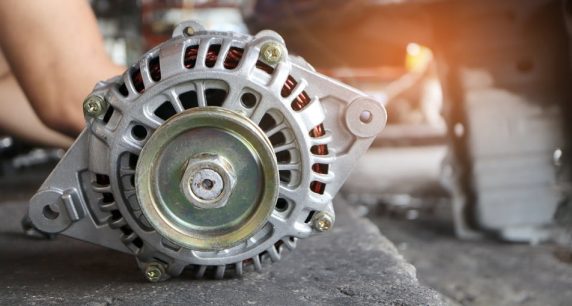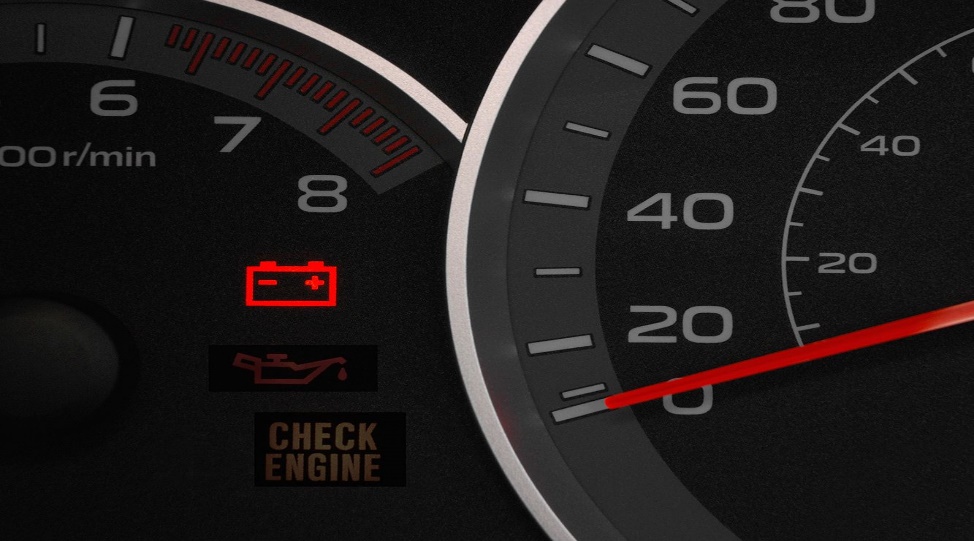7 Signs of A Failing Alternator

23 March, 2022
- DIM OR OVERLY BRIGHT LIGHTS
 When an alternator begins to fail, it provides inconsistent voltage to your electronic accessories. Generally, that takes the form of under- or over-performing equipment, such as headlights that are either too dim or extremely bright. You may also experience flickering lights or lights that erratically go from bright to dim and vice-versa.
When an alternator begins to fail, it provides inconsistent voltage to your electronic accessories. Generally, that takes the form of under- or over-performing equipment, such as headlights that are either too dim or extremely bright. You may also experience flickering lights or lights that erratically go from bright to dim and vice-versa. - DEAD BATTERY
 Sometimes a dead battery is just a dead battery — it’s reached the end of its life after a few years of use — or maybe you accidentally left the headlights on all night. Other times, however, a dead battery could be a sign that your alternator is malfunctioning.A bad alternator won’t sufficiently charge the battery while the engine is running, causing the charge to deplete faster than usual. One way to test whether the issue is battery- or alternator-related is to jumpstart the car. If you jumpstart your car and it stays running, your battery may need replacing soon. However, if you jumpstart the car and it dies again shortly after, it might mean your alternator isn’t getting enough power to the battery.
Sometimes a dead battery is just a dead battery — it’s reached the end of its life after a few years of use — or maybe you accidentally left the headlights on all night. Other times, however, a dead battery could be a sign that your alternator is malfunctioning.A bad alternator won’t sufficiently charge the battery while the engine is running, causing the charge to deplete faster than usual. One way to test whether the issue is battery- or alternator-related is to jumpstart the car. If you jumpstart your car and it stays running, your battery may need replacing soon. However, if you jumpstart the car and it dies again shortly after, it might mean your alternator isn’t getting enough power to the battery. - SLOW OR MALFUNCTIONING ACCESSORIES
An alternator that isn’t supplying enough power to your car’s electronics often results in slow or non-working accessories. If you notice your windows taking longer than usual to roll up or down, or if your seat warmers feel “off”, or even if your speedometer and other instruments start going haywire, you may have an alternator problem.Many modern vehicles also have a priority list of equipment programmed into the car that tells the on-board computer where to cut power first if the alternator isn’t supplying enough electricity. That way, if you’re driving with a failing alternator, you’ll lose power to your radio (or other nonessential accessories) before losing power to your headlights. - ROUBLE STARTING OR FREQUENT STALLING
 As previously mentioned, trouble starting your engine might mean that your alternator is failing to charge the battery. This means that when you turn the key in the ignition, all you’ll hear is a clicking sound instead of the purr of your engine.On the other hand, if your car is frequently stalling out while driving, it may be a sign that the spark plugs aren’t getting enough power from the alternator to keep the engine running.
As previously mentioned, trouble starting your engine might mean that your alternator is failing to charge the battery. This means that when you turn the key in the ignition, all you’ll hear is a clicking sound instead of the purr of your engine.On the other hand, if your car is frequently stalling out while driving, it may be a sign that the spark plugs aren’t getting enough power from the alternator to keep the engine running. - GROWLING OR WHINING NOISESCars make a ton of odd sounds — some are harmless while others can indicate serious mechanical problems. If you ever hear growling or whining noises coming from under the hood, you could have alternator problems, which should be checked out by a professional ASAP.This growling or whining sound happens when the belt that turns the alternator’s pulley becomes misaligned or rubs against the side of the pulley. You may also hear this sound if the bearings that spin the rotor shaft are going bad.
- SMELL OF BURNING RUBBER OR WIRESA foul odour of burning rubber or wires could indicate that parts of your alternator are starting to wear out. Because the alternator’s drive belt is under constant tension and friction — and because it’s close to the hot engine — it may wear out over time and emit an unpleasant burning rubber smell.Similarly, if your alternator is being overworked or if it has frayed or damaged wires, you may smell a burning odour comparable to an electrical fire. An overworked alternator tries to push too much electricity through its wires, causing them to heat up unsafely. Damaged wires also create resistance to the flow of electricity, causing the wires to heat up and emit a foul odour.
- BATTERY WARNING LIGHT ON DASH

When the battery warning light pops up on the dashboard, it’s commonly mistaken to be a battery-specific issue. However, the battery warning light indicates that there could be a problem within the wider electrical system of your car, including the alternator.Alternators are designed to work at a specific voltage, typically between 13-14.5 volts. If your alternator is failing, its voltage may drop below capacity, causing the battery warning light to appear on your dash. Similarly, the battery light will also appear if the alternator is exceeding its voltage limit, depending on how much stress it is under.Depending on the electrical load from your car’s accessories (headlights, wipers, radio, etc.), you may see the battery warning light flicker on and off as the alternator fluctuates in and out of its intended voltage capacity. While this may seem like a minor annoyance, it’s better to bring your car in for an alternator inspection rather than wind up stuck on the side of the road.
Recent Posts
14 February, 2025
> Read More

 When an alternator begins to fail, it provides inconsistent voltage to your electronic accessories. Generally, that takes the form of under- or over-performing equipment, such as headlights that are either too dim or extremely bright. You may also experience flickering lights or lights that erratically go from bright to dim and vice-versa.
When an alternator begins to fail, it provides inconsistent voltage to your electronic accessories. Generally, that takes the form of under- or over-performing equipment, such as headlights that are either too dim or extremely bright. You may also experience flickering lights or lights that erratically go from bright to dim and vice-versa. Sometimes a dead battery is just a dead battery — it’s reached the end of its life after a few years of use — or maybe you accidentally left the headlights on all night. Other times, however, a dead battery could be a sign that your alternator is malfunctioning.A bad alternator won’t sufficiently charge the battery while the engine is running, causing the charge to deplete faster than usual. One way to test whether the issue is battery- or alternator-related is to jumpstart the car. If you jumpstart your car and it stays running, your battery may need replacing soon. However, if you jumpstart the car and it dies again shortly after, it might mean your alternator isn’t getting enough power to the battery.
Sometimes a dead battery is just a dead battery — it’s reached the end of its life after a few years of use — or maybe you accidentally left the headlights on all night. Other times, however, a dead battery could be a sign that your alternator is malfunctioning.A bad alternator won’t sufficiently charge the battery while the engine is running, causing the charge to deplete faster than usual. One way to test whether the issue is battery- or alternator-related is to jumpstart the car. If you jumpstart your car and it stays running, your battery may need replacing soon. However, if you jumpstart the car and it dies again shortly after, it might mean your alternator isn’t getting enough power to the battery. As previously mentioned, trouble starting your engine might mean that your alternator is failing to charge the battery. This means that when you turn the key in the ignition, all you’ll hear is a clicking sound instead of the purr of your engine.On the other hand, if your car is frequently stalling out while driving, it may be a sign that the spark plugs aren’t getting enough power from the alternator to keep the engine running.
As previously mentioned, trouble starting your engine might mean that your alternator is failing to charge the battery. This means that when you turn the key in the ignition, all you’ll hear is a clicking sound instead of the purr of your engine.On the other hand, if your car is frequently stalling out while driving, it may be a sign that the spark plugs aren’t getting enough power from the alternator to keep the engine running.


